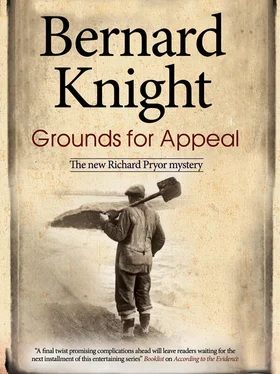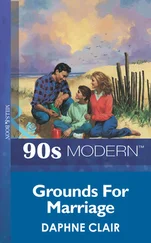Bernard Knight - Grounds for Appeal
Здесь есть возможность читать онлайн «Bernard Knight - Grounds for Appeal» весь текст электронной книги совершенно бесплатно (целиком полную версию без сокращений). В некоторых случаях можно слушать аудио, скачать через торрент в формате fb2 и присутствует краткое содержание. Жанр: Классический детектив, на английском языке. Описание произведения, (предисловие) а так же отзывы посетителей доступны на портале библиотеки ЛибКат.
- Название:Grounds for Appeal
- Автор:
- Жанр:
- Год:неизвестен
- ISBN:нет данных
- Рейтинг книги:4 / 5. Голосов: 1
-
Избранное:Добавить в избранное
- Отзывы:
-
Ваша оценка:
- 80
- 1
- 2
- 3
- 4
- 5
Grounds for Appeal: краткое содержание, описание и аннотация
Предлагаем к чтению аннотацию, описание, краткое содержание или предисловие (зависит от того, что написал сам автор книги «Grounds for Appeal»). Если вы не нашли необходимую информацию о книге — напишите в комментариях, мы постараемся отыскать её.
Grounds for Appeal — читать онлайн бесплатно полную книгу (весь текст) целиком
Ниже представлен текст книги, разбитый по страницам. Система сохранения места последней прочитанной страницы, позволяет с удобством читать онлайн бесплатно книгу «Grounds for Appeal», без необходимости каждый раз заново искать на чём Вы остановились. Поставьте закладку, и сможете в любой момент перейти на страницу, на которой закончили чтение.
Интервал:
Закладка:
‘But why could not the same spots have come from the chest wound?’ demanded Marchmont. ‘Her hand, whether left or right, would be virtually touching the chest if she stuck the knife in it.’
Angela shook her head and proffered the photograph album, opened at a page showing a close-up of the woman’s jacket sleeve.
‘These are a shower of tiny spots, quite well spaced. They are not contact smears; they are from a fine spray striking the cuff area.’ She held out her left arm and indicated the outside of her own sleeve, just above the wrist.
‘I think Doctor Pryor will bear me out in my opinion that a single stab wound through clothing in the chest, which did not penetrate any substantial arterial blood-vessels, would not produce any spray, as virtually all of the fatal bleeding was internal, within the chest organs.’
Though she needed little support, Richard came in here to confirm what she was saying.
‘You can see from the photographs of the body at the scene that there was hardly any bleeding externally. He was wearing a vest, shirt and waistcoat and all that is visible is a stain soaked into the cloth around the narrow slit where the knife went in.’
‘Could this spray not have come off the knife when it was pulled out?’ asked Douglas Bailey. ‘I’ve been involved in cases where there’s blood all over the room — even on the ceiling — from spatter off a weapon.’
‘Sure, that happens, usually with blunt instruments or things like axes. But almost always, the weapon has been applied to surfaces that are already bloody from previous blows. Usually, a single blow causes a momentary contraction of blood vessels and it’s a few seconds before enough blood flows for the second or third blow to pick enough liquid to throw around the place.’
‘And Millie hit him at least twice on the nose with her bottle,’ concluded Angela. ‘So she could have caused a splash with her second impact, throwing a local spray back on to her sleeve.’
‘The other thing is that when the knife was found on the floor, only a close inspection could tell it had been used,’ said Richard, with a quickening fluency of which his grandfather, a Welsh Methodist preacher, would have approved. ‘There were some faint dried blood smears on the blade, but it took proper examination in the laboratory to confirm it. So there was very little blood on it, certainly not enough to cause a shower of spots. When a knife is pulled out cleanly from a wound, the muscle contraction can close the edges tightly against the blade and wipe it. And then of course there were three layers of clothing to give it an additional wipe.’
The QC nodded. ‘You’ve convinced me, doctors, but we have to convince three sceptical Lords of Appeal. Now what about the time of death? That’s where we will win or lose.’
Coffee appeared, giving Richard time mentally to gird his loins before setting off on a much more detailed argument.
‘Let me make it clear, Mr Marchmont,’ he began after they had settled down again. ‘I cannot deny that Arthur Shaw might well have died at around eleven or twelve o’clock that night, as the prosecution claimed. But what I can do is show that, because of the uncertainty of the methods their pathologist relied on, he could have died several hours either side of that claim. Obviously, that could not have been on the earlier side, as a number of the people in the house saw him alive until he went upstairs to assault Millie. But the hours after that time are certainly in contention.’
‘This is where we need a detailed argument, Doctor Pryor,’ said Paul Marchmont. ‘You are directly at odds with their expert on this.’
‘Right, let’s take the easy ones first,’ said Richard. ‘Their Doctor Mackintyre said that he relied on a concurrence of post-mortem lividity, rigor mortis, stomach contents and temperature to arrive at his conclusion that death had occurred between eleven and twelve o’clock. That is utter nonsense, as any medical man who, from an imperfect examination fourteen hours later, puts a time of death within a one-hour bracket is either ignorant or foolish!’
‘Strong words, doctor!’ said the QC.
‘If he had said “consistent with those times”, I would agree with him, but that then fails to destroy Millie’s alibi, as someone else could have done the deed outside the very short time bracket.’
Marchmont once again tossed his hair back. ‘Carry on, please, doctor.’
‘First, lividity, or “livor mortis” as it was probably called in Doctor Mackintyre’s day. Completely useless as a timer of death. It can even occur in deep coma, such as barbiturate overdose. But the time it takes to appear due to gravitational settling of the red blood cells is extremely variable. To use that to pin down a time to an hour, when seen half a day later, is little short of ludicrous.’
Penelope Forbes, who had been very quiet in the presence of her leader, came in with a query that showed that she had researched the case in depth.
‘Haven’t I read that this lividity becomes fixed after a certain number of hours, which can be used in timing?’
‘That is certainly in all the textbooks, but in practice it is very variable and often doesn’t occur at all,’ was the firm reply. ‘I’ve experimented myself and found it to be totally unreliable.’
Douglas Bailey was getting out of his depth here. ‘Can you explain that, Doctor Pryor?’
‘When the blood cells settle, they are still inside the veins under the skin, so that the dark reddish-purple colour is visible. The delay for this to happen is very variable — in fact, in some old or anaemic people, it is never visible. Now if the body is moved after death, such as being turned over, the blood may or may not reposition itself towards the new lowest areas. Sometimes it does, sometimes it doesn’t. For years, pathologists and police surgeons have tried to put a timeline on when it stops moving and becomes fixed. But even when fixation does occur, it’s so random in its timing as to be useless. I’ve copied out the opinions given for this and for timing rigor mortis from almost a dozen textbooks of forensic medicine and you will see that the range of disagreement runs to many hours, so it’s of virtually no value!’
He passed around a few carbon copies of Moira’s typing and waited until the three lawyers had scanned them.
‘So what about rigor mortis? That’s always held up in detective novels to be the bee’s knees for timing death,’ said Paul Marchmont.
‘Much the same criticism as with hypostasis,’ replied Richard. ‘There are generalizations, which are not at all accurate — and so many exceptions to the generalizations that no useful rules remain.’
‘Can you expand on that a little, doctor? asked Penelope Forbes. Angela watched her partner and recognized him getting into lecture mode. She knew he was good at it and wondered if his students in Bristol University appreciated him.
‘Rigor is stiffening of all the muscles of the body after death, due to a chemical reaction affecting their proteins. The problem is that there are a number of factors which affect the speed and intensity of this stiffening. For example, strenuous activity shortly before death hastens it appreciably, which is why battle casualties often have a rapid onset of rigor. The same happens after electric shock. Then temperature also accelerates it and cold delays it. I’ve seen a body dead in the snow for some days with no rigor, but as soon as it was brought into the mortuary, it stiffened up.’
‘It was a very hot period when Arthur Shaw died in June last year,’ interjected the solicitor. ‘It was virtually a heatwave.’
‘I realized that, Mr Bailey, which was why I phoned the weather people at Bristol Airport the other day. Their records showed that the temperature, even at midnight, was much higher than usual for that date, so there’s another factor to use in the argument.’
Читать дальшеИнтервал:
Закладка:
Похожие книги на «Grounds for Appeal»
Представляем Вашему вниманию похожие книги на «Grounds for Appeal» списком для выбора. Мы отобрали схожую по названию и смыслу литературу в надежде предоставить читателям больше вариантов отыскать новые, интересные, ещё непрочитанные произведения.
Обсуждение, отзывы о книге «Grounds for Appeal» и просто собственные мнения читателей. Оставьте ваши комментарии, напишите, что Вы думаете о произведении, его смысле или главных героях. Укажите что конкретно понравилось, а что нет, и почему Вы так считаете.












